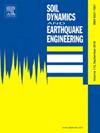地震灾害分析中多阻尼水平反应谱的概率评估
IF 4.2
2区 工程技术
Q1 ENGINEERING, GEOLOGICAL
引用次数: 0
摘要
基于概率地震危险性分析(PSHA),在阻尼比为5%的情况下,构造了特定重复周期的响应谱。然而,实际结构表现出一系列的阻尼特性,需要在不同阻尼水平下的响应谱。通常,应用阻尼修正因子(DMF)来调整从PSHA导出的5%阻尼谱到其他阻尼水平。然而,大多数DMF公式仅仅是通过对地震记录的回归分析得出的,忽略了调整前后响应谱重现期的一致性。对不同阻尼比下的响应谱进行直接概率分析提供了更合理的解决方案,尽管它通常需要为每个阻尼水平提供多个地震动预测方程(GMPEs),或者,应用DMF来调整5%阻尼的GMPE。然而,最近的许多研究都强调了通过地震学理论直接限制GMPEs内反应谱的标度的困难。为了解决这一问题,本研究提出了一个新的框架,用于进行跨多个阻尼比的响应谱的概率分析。该框架使用傅立叶振幅谱(FAS)的单一GMPE结合地面运动持续时间模型来估计不同阻尼比的特定地点响应谱。由于FAS与波传播的物理学更密切相关,因此使用地震学理论更容易约束其在GMPEs中的标度。在此基础上,应用矩量法结合拉丁超立方采样,计算了任意阻尼比下的反应谱的超越概率,得到了相应的地震危险性曲线。通过数值算例对该框架进行了验证,并与传统方法进行了比较。所提出的框架能够在任何期望的阻尼比下获取不同复发周期的响应谱,同时消除了为各种阻尼比构建多个GMPEs或开发DMF模型的需要。本文章由计算机程序翻译,如有差异,请以英文原文为准。
Probabilistic assessment of response spectra for multiple damping levels in seismic hazard analysis
The response spectra for specific recurrence periods are typically constructed for a 5 % damping ratio based on probabilistic seismic hazard analysis (PSHA). Nevertheless, practical structures exhibit a range of damping characteristics, requiring response spectra at various damping levels. Commonly, a damping modification factor (DMF) is applied to adjust the 5 %-damped spectra derived from PSHA to other damping levels. Most DMF formulations, however, are developed solely through the regression analysis of seismic records, overlooking the consistency of the recurrence period of the response spectra before and after adjustment. A direct probabilistic analysis of the response spectra across different damping ratios provides a more reasonable solution, although it typically needs multiple ground motion prediction equations (GMPEs) for each damping level or, alternatively, the application of a DMF to adjust the 5 %-damped GMPE. However, many recent studies have highlighted the difficulty of directly constraining the scaling of the response spectra within GMPEs via seismological theory. To address this issue, this study proposes a new framework for conducting a probabilistic analysis of the response spectra across multiple damping ratios. The framework estimates site-specific response spectra for various damping ratios using a single GMPE for the Fourier amplitude spectrum (FAS) combined with a ground-motion duration model. Because the FAS is more closely related to the physics of wave propagation, its scaling within GMPEs is easier to constrain using seismological theory. Furthermore, the moment method, in conjunction with Latin hypercube sampling, is applied to calculate the exceedance probability for response spectra with any damping ratio, thereby obtaining the corresponding seismic hazard curves. The proposed framework was verified and compared with traditional approaches using a numerical example. The proposed framework enables the acquisition of response spectra for distinct recurrence periods at any desired damping ratio while eliminating the need to construct multiple GMPEs for various damping ratios or to develop DMF models.
求助全文
通过发布文献求助,成功后即可免费获取论文全文。
去求助
来源期刊

Soil Dynamics and Earthquake Engineering
工程技术-地球科学综合
CiteScore
7.50
自引率
15.00%
发文量
446
审稿时长
8 months
期刊介绍:
The journal aims to encourage and enhance the role of mechanics and other disciplines as they relate to earthquake engineering by providing opportunities for the publication of the work of applied mathematicians, engineers and other applied scientists involved in solving problems closely related to the field of earthquake engineering and geotechnical earthquake engineering.
Emphasis is placed on new concepts and techniques, but case histories will also be published if they enhance the presentation and understanding of new technical concepts.
 求助内容:
求助内容: 应助结果提醒方式:
应助结果提醒方式:


